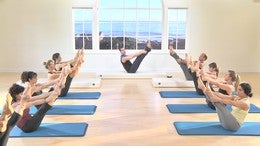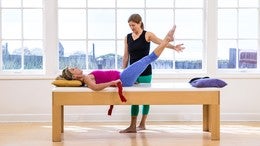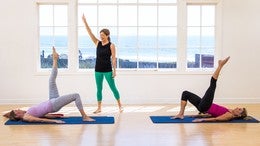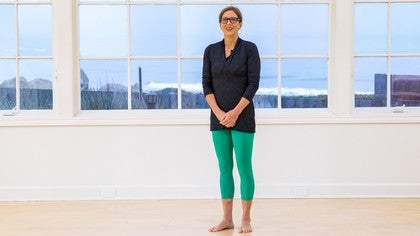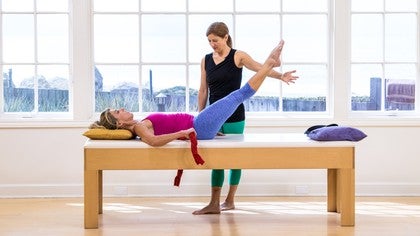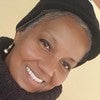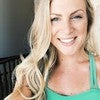Introduction #2813
Osteoporosis Modifications
Description
About This Video
Transcript
Read Full Transcript
Hi, I'm Sherry bets and I'm a physical therapist and PMA certified pilates teacher and a Divo t of safe exercise for osteoporosis. I'm back here at PyLadies anytime. Again to share some information about modifying exercises for osteoporosis. We're going to take each PyLadies mat exercise and break it down into the modifications that would be safe and effective for osteoporosis. And I'll also teach a [inaudible] map class that will be safe for osteoporosis.
Now today, people are sitting more often at computers and they don't even have to get off the couch to do their grocery shopping or change the TV channel. So with this in mind, I think this has changed so, so much during the last 50 years from when Joseph [inaudible] was doing his work. I think we need to take that into consideration very much so when we're designing an exercise program, especially one that's going to be safe and effective for osteoporosis. Joseph [inaudible], he said that gravity was our worst enemy, but actually science tells us that gravity is our bones best friend without gravity will actually lose bone density. And when astronauts go up into space, they often lose. Quite a bit of bone density, so they are doing strenuous exercise programs with heavy loads in order to preserve the density of their bones.
We know from the research also that we need high intensity exercise in order to build bone and also to build muscle strength. What builds muscle also builds bone. This means that the exercises have to fatigue the muscles within eight to 12 repetitions so that we're building muscle strength and bone. So then if we're doing exercises that won't fatigue the muscle within 15 to 20 exercises. If we, if we do 15 to 20 reps of an exercise, then we are doing more endurance focused exercise and that is not as effective for building strength and that would be pure muscle strength or even bone strength. This actually builds cardiovascular health and if you can go hike a mountain, people say, Oh, I'm climbing hills, I'm hiking on on steep terrain, I'm mountain biking. You're performing hundreds and hundreds of repetitions, which still really doesn't build bone strength.
Just last week I evaluated a lady who came in for knee pain and she had been having knee pain with hiking and she was an avid hiker, climbing steep hills, going on 10 to 15 mile hikes on a regular basis. When I evaluated her muscle strength, she could not get down to the floor and back up again. She couldn't even do a partial lunge because her legs were so weak. So this is something that was very surprising to her. She had no idea how weak her muscle strength actually was.
And that's somebody that has an excellent cardiovascular status and excellent endurance. So when we're building our PyLadies mat classes, we want to think this, and I think that plot is tends to plateau after a while because we're only using gravity and body weight and we need to think about possibly adding resistance to our exercises to target the muscles of the legs, especially and of the spine. Those are the two areas that we'll be focused on in order to build bone there. There's a predominance of supine exercises in the [inaudible] method. As we know from the mat work and from what I understand from the elders, Joseph [inaudible] said that he wanted to flatten the spine and straighten the spine like and make it flat more like a newborn baby. Well, if that is not really our focus and we're trying to build bone strength and muscle strength in the spine, we're going to want to have more of a predominance of neutral and extension exercises. This is going to translate better into function and certainly prevent fractures and also bone, sorry, disc injuries to the spine, so these are going to be safer for learning how to lift heavy objects and function in daily life. It doesn't mean that rounding your spine is a bad thing, but it can put the spine at risk for fracture.
If someone has low bone density and you're loading those vertebral bodies in the front of the spine, we're going to be dividing the exercises into supine sideline prone and sitting and then talking about each one of those categories so that you can take each individual exercise and modify it for either a private client or putting it together into a more balanced mat class. We know that one out of every two women and one out of every four men are at risk for fracture because they have low bone density. By the time someone reaches 50 years old, that's the risk. How many people in your mat classes are over 50 I bet there's a big predominance of people in that age range. So likely 50% of your people in the Mat class could have osteoporosis even though they're not telling you. So.
How about if you learn to teach a math class to 40 50 people in a health club setting? That would be safe for anyone to do and then you can layer on the exercises for people that have normal bone density. Norton Owen, the archivist from Jacob's pillow who was present when Joseph [inaudible] was teaching exercises there said that Joseph [inaudible] designed his mat classes and more of a developmental sequence. Much like babies learn to have trunk control. They're on their back, they roll to their side, they get on their stomach, they build their back, strengthen their trunk strength by laying on their stomach and controlling their heavy head in relation to the small light body. He wanted the exercises to build that strength in the spine. It makes a lot of sense so that you end the class in standing. However, I really like to start my class in standing to get people to kind of key into their posture. And a lot of times when people come into the class, they lay down, they get on the foam roller, they kind of chat with their neighbors and they're not really that focused sometimes. But I bet you if you get your clients standing on one leg, they won't be talking to their neighbors.
They won't be thinking about their grocery list and they will focus on their body. So I like to start with some balance and standing exercises in my classes for that reason, and then I like to bring pat people back up to standing after they've done all the work to reintegrate their body and I find that it's very effective. We don't think of standing balancing, squatting, jumping as plots, but really when Joseph Flonase was teaching at Jacob's pillow, that's exactly how he wants people up. He was doing jumping exercises, jumping jacks, and and running in place in order to get people warmed up before they got down on the mats and did the a hundred which I think is really smart because then the spine is much warmer and it's a lot safer to do exercises in that way. Benjamin Dagon heart in class number 1589 he unfollowed. He's anytime did a wonderful job of warming up his class in exactly that way.
He also taught the sitting rising test, which is actually a test that was developed by a man named Brito from Brazil in 2014 looking at the function of older adults in the ability to get down to the floor and back up again with that cross leg technique. If you had to put your hand down or your knee down, you actually lost points on your score. So someone that scored a 10 would be able to cross their arms in front, sit down with their legs crossed and stand back up without touching a knee or the hand. Now I know a lot of people can't do that, so we're going to show you some modifications in ways for doing that. If you have knees that don't tolerate that position, but I challenge you to go to try that mat class that Benjamin Degenhart taught and see how he warms people up in that way. Thought it was a really great class. One other thing I'd like to mention is that when the spine is cold at the beginning of the day and that maybe you're going to class at 7:00 AM in the morning and you jumped down on the floor and start doing the hundred the roll up and the rollover with the rollover as the very third exercise with a cold spine, you're going to have something called neural tension in the body.
Some people don't experience that if they have a lot of mobility, but most of us have a little bit of neural tension. The disc will imbibe water throughout the night and be a little bit fuller so that the spine is not quite as flexible in the morning as it would be in the afternoon when you've moved throughout the day. And also in Yoga when they put together their developmental sequence of exercises or poses, they end the class with rollover shoulder stand plow, those kind of movements and those extreme twists of the spine and they put those at the end of the class when the spine is very warm and I think that's very smart. That's going to reduce the risk of injury if you take your, your extreme spine motions and put them at the end of the class or when you're warm. So that being said, we're not going to be doing extremes of range of motion in the spine for people with osteoporosis, but we want to think about that for people that don't have osteoporosis as well. So let's get started on looking at each individual mat exercise, and then we'll also look at a class and you can participate in a class that is a pretty fast paced, that's more based on a classical sequencing and including some of the classical exercises and how you would modify them. For somebody that's pretty advanced and knows the work well.
Bone Health: Modifications for Osteoporosis
Comments
Your comment is very important to me. I am so glad that my respect for Joseph Pilates work came through and that it is not about contemporary vs. classical. It is about what is best for the client in front of us! Thank you, again, I am grateful for your feedback!
I see many Pilates teachers still teaching exercises that load the spine when clients have mentioned on intake they have low bone density or osteoporosis. There needs to be more emphasis within the teaching institutions. Great job, Sherri! Thank you for your insight and education. Congrats on your award as well!!
You need to be a subscriber to post a comment.
Please Log In or Create an Account to start your free trial.
